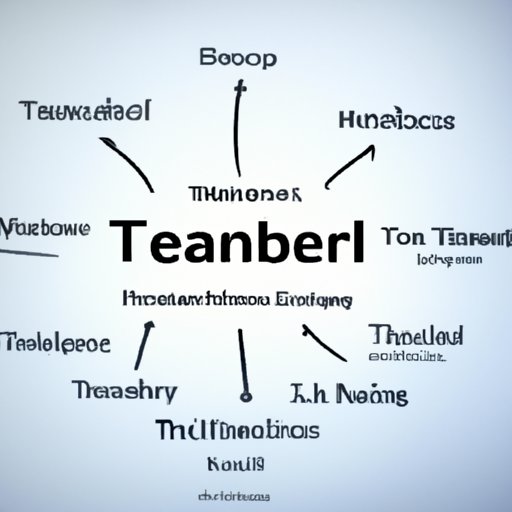Introduction
A team leader is someone who has the responsibility for managing a group of people in a workplace setting. They must have strong leadership and interpersonal skills in order to effectively guide a team towards achieving its goals. But what makes a great team leader? In this article, we will explore the qualities of a great team leader, the benefits they bring to their teams, and the challenges they face.
Identifying the Qualities of a Great Team Leader
There are many qualities that make a great team leader. Here are some of the most important ones:
Communication Skills
Effective communication is essential for any team leader. A great leader needs to be able to clearly articulate their vision for the team and make sure everyone understands their role in achieving it. They should also be open to feedback from team members and willing to listen to their ideas and concerns.
Ability to Delegate
A great team leader is also able to delegate tasks and responsibilities to the right people. They understand that not everyone on the team has the same strengths and weaknesses, so they can identify the best person for each task. This helps ensure that the team is working efficiently and that everyone is contributing in a meaningful way.
Setting Expectations and Holding People Accountable
A great team leader is able to set clear expectations and hold people accountable for their actions. They understand that accountability is key to ensuring that the team is meeting its goals. They also know how to give constructive criticism when needed and provide support and encouragement when things don’t go according to plan.
Inspiring and Motivating Others
A great team leader is able to inspire and motivate their team members to do their best work. They understand the importance of creating a positive and supportive environment where everyone feels valued and appreciated. They also recognize the power of recognition and rewards as a way to encourage team members to stay motivated and engaged.
Emotional Intelligence
A great team leader also has strong emotional intelligence. They understand the dynamics of the team and can read people’s emotions. This helps them to better manage conflict and build strong relationships with their team members. They also know how to be empathetic and compassionate when needed.
Problem-Solving Abilities
A great team leader is also able to think creatively and come up with innovative solutions to problems. They understand the importance of taking risks and are comfortable with making decisions that may not always be popular. They also know how to weigh all the options and come up with the best solution for the team.
Demonstrating Trust and Respect
Finally, a great team leader is able to foster an environment of trust and respect. They understand the importance of recognizing individual contributions and treating everyone with dignity and respect. They also create an environment where team members feel comfortable expressing their opinions and ideas without fear of being judged or ridiculed.
Exploring the Benefits of a Great Team Leader
Having a great team leader can have numerous benefits for the team. Here are some of the most common ones:
Improved Morale
A great team leader is able to create a positive and supportive environment where everyone feels valued and appreciated. This can help boost morale and make team members more motivated to do their best work. According to a study by the Harvard Business Review, “When employees feel respected and appreciated, they are more likely to go above and beyond for the team.”
Increased Productivity
A great team leader is able to set clear expectations and hold people accountable for their actions. This can help ensure that the team is working efficiently and that everyone is contributing in a meaningful way. Studies have shown that teams with effective leaders are more productive than those without.
More Efficient Workflow
A great team leader also understands the importance of delegating tasks and responsibilities to the right people. This helps to ensure that tasks are completed in a timely manner and that there is minimal disruption to the workflow. As a result, the team is able to work more efficiently and get more done in less time.
Greater Creativity and Innovation
A great team leader is also able to foster an environment of creativity and innovation. They understand the importance of allowing team members to take risks and try new things. They also recognize the power of collaboration and encourage team members to share their ideas and opinions. This can lead to greater creativity and innovation within the team.

Examining Examples of Exceptional Team Leaders
Throughout history, there have been many exceptional team leaders who have had a profound impact on their teams and organizations. Here are some of the most notable examples:
Steve Jobs
Steve Jobs was a legendary entrepreneur and co-founder of Apple. He was known for his unique vision and ability to motivate and inspire his team. He was also known for his willingness to take risks and push the boundaries of technology. His legacy lives on through the success of Apple and other companies he helped to create.
Jack Welch
Jack Welch was the former CEO of General Electric. He was known for his ability to motivate and inspire his team and for his focus on performance and results. He believed in holding people accountable and rewarding excellence. He was also known for his passion for innovation and his commitment to customer satisfaction.
Mary Barra
Mary Barra is the current CEO of General Motors. She is known for her focus on safety and quality and for her commitment to diversity and inclusion. She is also known for her ability to embrace change and challenge the status quo. Her leadership has been instrumental in transforming GM into a global leader in the automotive industry.
Richard Branson
Richard Branson is the founder of the Virgin Group. He is known for his entrepreneurial spirit and his ability to think outside the box. He is also known for his willingness to take risks and his focus on building strong relationships with his team members. His leadership has been instrumental in building a successful and enduring business empire.

Investigating the Challenges of Being a Team Leader
Being a team leader is not without its challenges. Here are some of the most common ones:
Balancing the Needs of the Team with the Needs of the Organization
A great team leader needs to be able to balance the needs of the team with the needs of the organization. They need to be able to prioritize tasks and ensure that the team is working towards achieving the organization’s goals. This can be difficult, as it requires a delicate balance between competing interests.
Dealing with Difficult Personalities
A great team leader also needs to be able to manage difficult personalities. They need to be able to keep the peace and maintain harmony within the team. This can be challenging, as it requires patience, understanding, and the ability to use diplomacy when necessary.
Managing Conflict
A great team leader also needs to be able to manage conflict effectively. They need to be able to identify the root causes of conflicts and find ways to resolve them peacefully. This can be difficult, as it requires the ability to remain impartial and objective while finding solutions that are acceptable to both sides.
Establishing Credibility with the Team
Finally, a great team leader needs to be able to establish credibility with the team. They need to be able to earn the respect and trust of their team members. This can be challenging, as it requires a combination of charisma, competence, and consistency.

Understanding How to Foster Successful Team Leadership
In order to foster successful team leadership, there are several steps that can be taken. Here are some of the most important ones:
Creating a Shared Vision
A great team leader needs to be able to create a shared vision for the team. They need to be able to articulate their vision in a way that resonates with the team and inspires them to achieve it. They also need to make sure that everyone understands their role in achieving the vision and is committed to working towards it.
Providing Feedback and Recognition
A great team leader also needs to be able to provide feedback and recognition to their team members. They need to be able to give constructive criticism when needed and provide support and encouragement when things don’t go according to plan. They also need to recognize individual achievements and reward excellence.
Building Strong Relationships
A great team leader also needs to be able to build strong relationships with their team members. They need to be able to create an environment where everyone feels valued and respected. They also need to be able to foster open and honest communication, which will help build trust and collaboration.
Encouraging Collaboration
Finally, a great team leader needs to be able to encourage collaboration amongst their team members. They need to be able to foster an environment where everyone can share their ideas and opinions without fear of being judged or ridiculed. They also need to recognize the value of allowing team members to take risks and try new things.
Conclusion
In conclusion, a great team leader is someone who has strong leadership and interpersonal skills, who is able to communicate effectively, delegate tasks and responsibilities, set expectations and hold people accountable, inspire and motivate others, demonstrate emotional intelligence, solve problems, and show trust and respect. A great team leader can bring numerous benefits to their team, including improved morale, increased productivity, more efficient workflow, and greater creativity and innovation. There are also several challenges that team leaders face, such as balancing the needs of the team with the needs of the organization, dealing with difficult personalities, managing conflict, and establishing credibility with the team. To foster successful team leadership, it is important to create a shared vision, provide feedback and recognition, build strong relationships, and encourage collaboration.
(Note: Is this article not meeting your expectations? Do you have knowledge or insights to share? Unlock new opportunities and expand your reach by joining our authors team. Click Registration to join us and share your expertise with our readers.)
